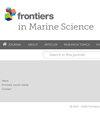预测宇航员海主要海洋哺乳动物的潜在分布
IF 3
2区 生物学
Q1 MARINE & FRESHWATER BIOLOGY
引用次数: 0
摘要
由于全球气候变化,南大洋是地球上一个重要的海洋区域,正在发生重大的环境变化,包括海冰面积减少、海洋酸化和南极环极流(ACC)的变化。宇航员海,以其动态的海冰和丰富的生物活动而闻名,仍然是南大洋中探索最少的地区之一,关于其海洋哺乳动物种群的数据有限。本研究是在2022年1月至3月的第38次中国国家南极科学考察(CHINARE)期间进行的,收集了海洋哺乳动物发生的系统数据。摘要采用物种分布模型(SDM),研究了环境变量对座头鲸(Megaptera novaeangliae)、食蟹海豹(Lobodon carcinophaga)和南极小须鲸(Balaenoptera bonaerensis)等在宇航员海中最丰富的海洋哺乳动物物种分布的影响。我们的研究结果表明,不同算法之间存在显著的性能差异,集成模型产生更准确的预测。水深、海面高度和混合层厚度等环境变量是影响不同物种生境适宜性的重要因素。座头鲸的分布范围最广,其次是南极小须鲸和食蟹海豹。总体而言,该研究首次提供了对宇航员海海洋哺乳动物分布的综合分析,突出了集合模型在生态预测中的有效性。这些发现强调了在未来的研究中整合高分辨率数据和纳入捕食者-猎物相互作用的重要性,以提高我们对这些复杂生态系统的理解和保护。本文章由计算机程序翻译,如有差异,请以英文原文为准。
Predicting the potential distribution of major marine mammals in the Cosmonaut Sea
The Southern Ocean, a critical marine region on Earth, is undergoing significant environmental changes due to global climate change, including reductions in sea ice extent, ocean acidification, and alterations in the Antarctic Circumpolar Current (ACC). The Cosmonaut Sea, notable for its dynamic sea ice and rich biological activity, remains one of the least explored regions in the Southern Ocean, with limited data on its marine mammal populations. This study conducted during the 38th Chinese National Antarctic Research Expedition (CHINARE) from January to March 2022, collected systematic data on marine mammal occurrences. Species distribution modeling (SDM) was used to assess the influence of environmental variables on the distribution of the most abundant marine mammal species observed in the Cosmonaut Sea, including humpback whales (Megaptera novaeangliae ), crabeater seals (Lobodon carcinophaga ), and Antarctic minke whales (Balaenoptera bonaerensis ). Our results indicated significant performance variations among the different algorithms, with ensemble model yielding more accurate predictions. Environmental variables such as water depth, sea surface height, and mixed layer thickness were identified as significant factors influencing habitat suitability for different species. Humpback whales were found to have the widest distribution range, followed by Antarctic minke whales and crabeater seals. Generally, the study provides the first comprehensive analysis of marine mammal distribution in the Cosmonaut Sea, highlighting the effectiveness of ensemble models in ecological predictions. The findings emphasize the importance of integrating high-resolution data and incorporating predator-prey interactions in future studies to improve our understanding and conservation of these complex ecosystems.
求助全文
通过发布文献求助,成功后即可免费获取论文全文。
去求助
来源期刊

Frontiers in Marine Science
Agricultural and Biological Sciences-Aquatic Science
CiteScore
5.10
自引率
16.20%
发文量
2443
审稿时长
14 weeks
期刊介绍:
Frontiers in Marine Science publishes rigorously peer-reviewed research that advances our understanding of all aspects of the environment, biology, ecosystem functioning and human interactions with the oceans. Field Chief Editor Carlos M. Duarte at King Abdullah University of Science and Technology Thuwal is supported by an outstanding Editorial Board of international researchers. This multidisciplinary open-access journal is at the forefront of disseminating and communicating scientific knowledge and impactful discoveries to researchers, academics, policy makers and the public worldwide.
With the human population predicted to reach 9 billion people by 2050, it is clear that traditional land resources will not suffice to meet the demand for food or energy, required to support high-quality livelihoods. As a result, the oceans are emerging as a source of untapped assets, with new innovative industries, such as aquaculture, marine biotechnology, marine energy and deep-sea mining growing rapidly under a new era characterized by rapid growth of a blue, ocean-based economy. The sustainability of the blue economy is closely dependent on our knowledge about how to mitigate the impacts of the multiple pressures on the ocean ecosystem associated with the increased scale and diversification of industry operations in the ocean and global human pressures on the environment. Therefore, Frontiers in Marine Science particularly welcomes the communication of research outcomes addressing ocean-based solutions for the emerging challenges, including improved forecasting and observational capacities, understanding biodiversity and ecosystem problems, locally and globally, effective management strategies to maintain ocean health, and an improved capacity to sustainably derive resources from the oceans.
 求助内容:
求助内容: 应助结果提醒方式:
应助结果提醒方式:


